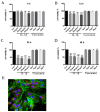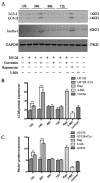Curcumin Inhibits Apoptosis of Chondrocytes through Activation ERK1/2 Signaling Pathways Induced Autophagy
- PMID: 28430129
- PMCID: PMC5409753
- DOI: 10.3390/nu9040414
Curcumin Inhibits Apoptosis of Chondrocytes through Activation ERK1/2 Signaling Pathways Induced Autophagy
Abstract
Osteoarthritis (OA) is an inflammatory disease of load-bearing synovial joints that is currently treated with drugs that exhibit numerous side effects and are only temporarily effective in treating pain, the main symptom of the disease. Consequently, there is an acute need for novel, safe, and more effective chemotherapeutic agents for the treatment of osteoarthritis and related arthritic diseases. Curcumin, the principal curcuminoid and the most active component in turmeric, is a biologically active phytochemical. Evidence from several recent in vitro studies suggests that curcumin may exert a chondroprotective effect through actions such as anti-inflammatory, anti-oxidative stress, and anti-catabolic activity that are critical for mitigating OA disease pathogenesis and symptoms. In the present study, we investigated the protective mechanisms of curcumin on interleukin 1β (IL-1β)-stimulated primary chondrocytes in vitro. The treatment of interleukin (IL)-1β significantly reduces the cell viability of chondrocytes in dose and time dependent manners. Co-treatment of curcumin with IL-1β significantly decreased the growth inhibition. We observed that curcumin inhibited IL-1β-induced apoptosis and caspase-3 activation in chondrocytes. Curcumin can increase the expression of phosphorylated extracellular signal-regulated kinases 1/2 (ERK1/2), autophagy marker light chain 3 (LC3)-II, and Beclin-1 in chondrocytes. The expression of autophagy markers could be decreased when the chondrocytes were incubated with ERK1/2 inhibitor U0126. Our results suggest that curcumin suppresses apoptosis and inflammatory signaling through its actions on the ERK1/2-induced autophagy in chondrocytes. We propose that curcumin should be explored further for the prophylactic treatment of osteoarthritis in humans and companion animals.
Keywords: ERK; apoptosis; autophagy; curcumin; osteoarthritis.
Conflict of interest statement
The authors declare no conflict of interest.
Figures







References
-
- Samuels J., Krasnokutsky S., Abramson S.B. Osteoarthritis: A tale of three tissues. Bull. NYU Hosp. Jt. Dis. 2008;66:244–250. - PubMed
-
- Zhang W., Moskowitz R.W., Nuki G., Abramson S., Altman R.D., Arden N., Bierma-Zeinstra S., Brandt K.D., Croft P., Doherty M., et al. OARSI recommendations for the management of hip and knee osteoarthritis, Part II: OARSI evidence-based, expert consensus guidelines. Osteoarthr. Cartil. 2008;16:137–162. doi: 10.1016/j.joca.2007.12.013. - DOI - PubMed
-
- Zhang W., Nuki G., Moskowitz R.W., Abramson S., Altman R.D., Arden N.K., Bierma-Zeinstra S., Brandt K.D., Croft P., Doherty M., et al. OARSI recommendations for the management of hip and knee osteoarthritis: Part III: Changes in evidence following systematic cumulative update of research published through January 2009. Osteoarthr. Cartil. 2010;18:476–499. doi: 10.1016/j.joca.2010.01.013. - DOI - PubMed
MeSH terms
Substances
LinkOut - more resources
Full Text Sources
Other Literature Sources
Research Materials
Miscellaneous

